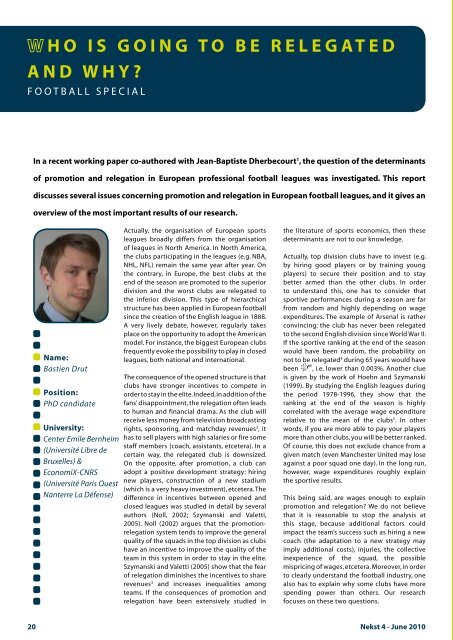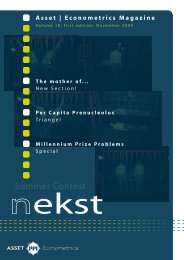fourth edition, June 2010 - Asset | Econometrics
fourth edition, June 2010 - Asset | Econometrics
fourth edition, June 2010 - Asset | Econometrics
Create successful ePaper yourself
Turn your PDF publications into a flip-book with our unique Google optimized e-Paper software.
h o i S g o i N g t o B E r E L E g A t E d<br />
A N d W h Y ?<br />
f O O T B a L L S P e C I a L<br />
in a recent working paper co-authored with Jean-Baptiste dherbecourt 1 , the question of the determinants<br />
of promotion and relegation in European professional football leagues was investigated. this report<br />
discusses several issues concerning promotion and relegation in European football leagues, and it gives an<br />
overview of the most important results of our research.<br />
Name:<br />
Bastien Drut<br />
Position:<br />
PhD candidate<br />
university:<br />
Center Emile Bernheim<br />
(Université Libre de<br />
Bruxelles) &<br />
EconomiX-CNRS<br />
(Université Paris Ouest<br />
Nanterre La Défense)<br />
actually, the organisation of european sports<br />
leagues broadly differs from the organisation<br />
of leagues in North america. In North america,<br />
the clubs participating in the leagues (e.g. NBa,<br />
NHL, NfL) remain the same year after year. On<br />
the contrary, in europe, the best clubs at the<br />
end of the season are promoted to the superior<br />
division and the worst clubs are relegated to<br />
the inferior division. This type of hierarchical<br />
structure has been applied in european football<br />
since the creation of the english league in 1888.<br />
a very lively debate, however, regularly takes<br />
place on the opportunity to adopt the american<br />
model. for instance, the biggest european clubs<br />
frequently evoke the possibility to play in closed<br />
leagues, both national and international.<br />
The consequence of the opened structure is that<br />
clubs have stronger incentives to compete in<br />
order to stay in the elite. Indeed, in addition of the<br />
fans’ disappointment, the relegation often leads<br />
to human and financial drama. as the club will<br />
receive less money from television broadcasting<br />
rights, sponsoring, and matchday revenues 2 , it<br />
has to sell players with high salaries or fire some<br />
staff members (coach, assistants, etcetera). In a<br />
certain way, the relegated club is downsized.<br />
On the opposite, after promotion, a club can<br />
adopt a positive development strategy: hiring<br />
new players, construction of a new stadium<br />
(which is a very heavy investment), etcetera. The<br />
difference in incentives between opened and<br />
closed leagues was studied in detail by several<br />
authors (Noll, 2002; Szymanski and Valetti,<br />
2005). Noll (2002) argues that the promotionrelegation<br />
system tends to improve the general<br />
quality of the squads in the top division as clubs<br />
have an incentive to improve the quality of the<br />
team in this system in order to stay in the elite.<br />
Szymanski and Valetti (2005) show that the fear<br />
of relegation diminishes the incentives to share<br />
revenues 3 and increases inequalities among<br />
teams. If the consequences of promotion and<br />
relegation have been extensively studied in<br />
the literature of sports economics, then these<br />
determinants are not to our knowledge.<br />
actually, top division clubs have to invest (e.g.<br />
by hiring good players or by training young<br />
players) to secure their position and to stay<br />
better armed than the other clubs. In order<br />
to understand this, one has to consider that<br />
sportive performances during a season are far<br />
from random and highly depending on wage<br />
expenditures. The example of arsenal is rather<br />
convincing: the club has never been relegated<br />
to the second english division since World War II.<br />
If the sportive ranking at the end of the season<br />
would have been random, the probability on<br />
not to be relegated 4 during 65 years would have<br />
been , i.e. lower than 0.003%. another clue<br />
is given by the work of Hoehn and Szymanski<br />
(1999). By studying the english leagues during<br />
the period 1978-1996, they show that the<br />
ranking at the end of the season is highly<br />
correlated with the average wage expenditure<br />
relative to the mean of the clubs 5 . In other<br />
words, if you are more able to pay your players<br />
more than other clubs, you will be better ranked.<br />
Of course, this does not exclude chance from a<br />
given match (even Manchester United may lose<br />
against a poor squad one day). In the long run,<br />
however, wage expenditures roughly explain<br />
the sportive results.<br />
This being said, are wages enough to explain<br />
promotion and relegation? We do not believe<br />
that it is reasonable to stop the analysis at<br />
this stage, because additional factors could<br />
impact the team’s success such as hiring a new<br />
coach (the adaptation to a new strategy may<br />
imply additional costs), injuries, the collective<br />
inexperience of the squad, the possible<br />
mispricing of wages, etcetera. Moreover, in order<br />
to clearly understand the football industry, one<br />
also has to explain why some clubs have more<br />
spending power than others. Our research<br />
focuses on these two questions.<br />
20 Nekst 4 - <strong>June</strong> <strong>2010</strong><br />
as the variable we want to explain (i.e.<br />
promotion or relegation) is binary, we<br />
use a logistic model. The explanatory<br />
variables contain the wage expenditures<br />
and some additional variables: average<br />
age of the players, percentage of<br />
foreign players, dummy whether there<br />
is a new manager. We concentrated<br />
our study on the english and french<br />
clubs as data on wages in other big<br />
european Championships were not<br />
available. for the moment, our results<br />
are still very preliminary. Of course, wage<br />
expenditures have a strong explanatory<br />
power, and obviously increase promotion<br />
probability and decrease relegation<br />
probability. We also found that hiring<br />
a new coach increases the relegation<br />
probability significantly whereas it has<br />
no significant impact on the promotion<br />
probability. another finding is that<br />
clubs with older players have a higher<br />
probability to go down in the Premier<br />
League, but not in the french league.<br />
a possible explanation is that very rich<br />
clubs have the possibility to detect and<br />
hire very young and talented players<br />
from all over the world. This has to be<br />
complemented with other variables<br />
though, in particular with governance<br />
indicators.<br />
In table 1, we expose the promotion<br />
and relegation probabilities for the<br />
Ligue 1 and the Ligue 2 (the first and<br />
second divisions of the french football<br />
league respectively) for the season<br />
2008-2009. The model yields rather<br />
good results as the clubs with a high<br />
relegation probability (a high promotion<br />
probability) are badly ranked (well<br />
ranked). The most striking result is that<br />
clubs are far from equal: 11 teams had<br />
a relegation probability smaller than or<br />
equal to 0.10 in Ligue 1. When the model<br />
fails, i.e. when it does not correctly predict<br />
promotion or relegation for a given<br />
season, it is very likely that this mistake<br />
will be corrected during the next season.<br />
for instance, even though the two teams<br />
with the highest relegation probability<br />
were not relegated during the season<br />
2008-2009, they were indeed relegated<br />
the next season. as far as the promotion<br />
is concerned, the two teams with the<br />
highest promotion probability (Lens and<br />
Montpellier) were promoted. The third<br />
promoted club, Boulogne-sur-Mer, had a<br />
Ligue 1 Ligue 2<br />
Final<br />
Final<br />
Club Relegation Probability Ranking Club Promotion Probability Ranking<br />
Grenoble 0.52 13 Lens 1.00 1<br />
Le Mans 0.43 16 Montpellier 0.73 2<br />
Nancy 0.29 15 Troyes 0.41 19<br />
Le Havre 0.29 20 Reims 0.28 20<br />
Valenciennes 0.28 12 Sedan 0.18 9<br />
St. Etienne 0.26 17 Guingamp 0.16 13<br />
Nice 0.18 9 Amiens 0.15 18<br />
Nantes 0.17 19 Chateauroux 0.13 15<br />
Caen 0.12 18 Metz 0.13 5<br />
Lorient 0.10 10 Nimes 0.10 17<br />
Toulouse 0.09 4 Boulogne 0.09 3<br />
Auxerre 0.08 8 Angers 0.09 7<br />
Lille 0.07 5 Ajaccio 0.09 16<br />
Sochaux 0.06 14 Strasbourg 0.08 4<br />
Monaco 0.04 11 Bastia 0.08 11<br />
Rennes 0.03 7 Dijon 0.08 8<br />
PSG 0.00 6 Brest 0.07 14<br />
Bordeaux 0.00 1 Clermont 0.06 12<br />
Marseille 0.00 2 Vannes 0.05 10<br />
Lyon 0.00 3 Tours 0.04 6<br />
Considering the fact that the best ranked clubs get the highest revenues 6 T a b l e 1<br />
and are in this way more<br />
able to attract talented players the following year, one can understand that a self-reinforcing<br />
phenomenon is occurring. The richest clubs hire relatively better players, are ranked better, earn<br />
more money, and so on. For this reason, freshly promoted clubs are unable to compete with wellestablished<br />
clubs in the first division and do not succeed in settling durably in the elite. In European<br />
very low promotion probability (0.09).<br />
Nonetheless, this club was eventually<br />
relegated to the second division at the<br />
end of the season 2009-<strong>2010</strong>.<br />
Considering the fact that the best<br />
ranked clubs get the highest revenues 6<br />
and are in this way more able to attract<br />
talented players the following year, one<br />
can understand that a self-reinforcing<br />
phenomenon is occurring. The richest<br />
clubs hire relatively better players, are<br />
ranked better, earn more money, and<br />
so on. for this reason, freshly promoted<br />
clubs are unable to compete with wellestablished<br />
clubs in the first division<br />
and do not succeed in settling durably<br />
in the elite. In european football<br />
championships, there is a hard core of<br />
clubs in the first division with a very low<br />
probability of relegation. Indeed, we may<br />
conclude that european football leagues<br />
are far less opened than one might think. |<br />
1. Dherbecourt J.-B. and B. Drut, Who will go down this<br />
year ? The determinants of promotion and relegation<br />
in european soccer leagues. Working Paper of<br />
Université Libre de Bruxelles, N°09-38.<br />
2. for professional football clubs, the revenues consist<br />
almost exclusively of television broadcasting rights,<br />
matchday revenues, and sponsoring.<br />
3. In most of the major european championships<br />
(england, Germany, france, and Italy soon), the<br />
league negotiates the television broadcasting rights<br />
collectively and subsequently redistributes the<br />
proceeds to the clubs by using its own criteria.<br />
4. Only the three worst-ranked teams at the end of the<br />
season are relegated.<br />
5. The r-square of the OLS regression is 0.92.<br />
6. for instance, television broadcasting rights are<br />
redistributed explicitly in function of sportive results.<br />
references<br />
Hoehn T. and S. Szymanski, 1999, The americanization<br />
of european football. Economic Policy, vol. 28, 205-240.<br />
Noll r., 2002, The economics of Promotion and<br />
relegation in Sports Leagues. Journal of Sports<br />
Economics, vol. 3(2), 169-203.<br />
Szymanski S. and T. Valetti, 2005, Promotion and<br />
relegation in Sporting Contests. Rivista di Politica<br />
Economica, vol. 95(5/6), 3-39.<br />
Nekst 4 - <strong>June</strong> <strong>2010</strong> 21




